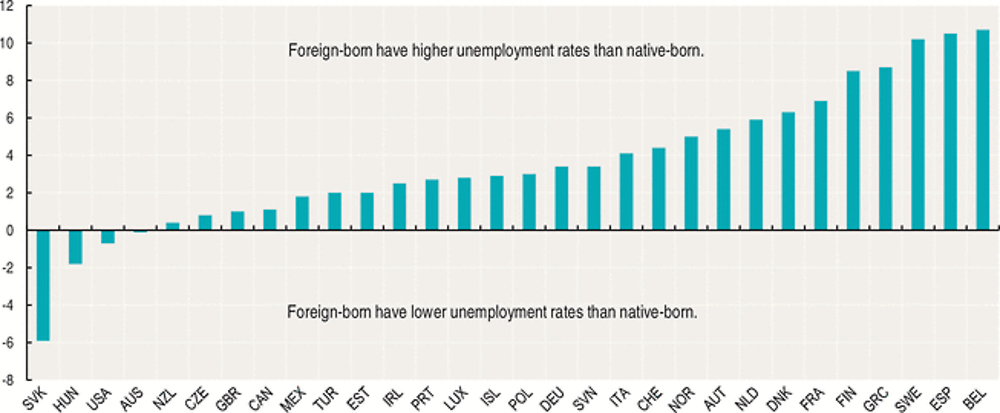Migration and unemployment
Immigrant workers are more affected by unemployment than native-born workers in traditional European immigration countries. Conversely, in some settlement countries (Australia, New Zealand and the United States) as well as in Hungary, the unemployment rate depends less on the place of birth. Some groups, such as young immigrants, women or older immigrants have greater difficulties in finding jobs.
Definition
The unemployment rate is the share of the unemployed aged 15-64 in the total labour force (the sum of employed and unemployed persons aged 15-64). In accordance with the ILO standards, unemployed persons consist of those persons who report that they are without work during the reference week, that they are available for work and that they have taken active steps to find work during the four weeks preceding the interview.
Comparability
Data for the European countries are from the European Union Labour Force Survey. Data for the United States come from the Current Population Survey; those for other countries are taken from their national labour force surveys. Even if unemployment levels can at times be affected by changes in the survey design and by survey implementation problems (e.g. non-response), data on unemployment rates are generally consistent over time.
The EU28 aggregate is a weighted average.
Immigrants were hard hit, and almost immediately, by the economic downturn in most OECD countries. This is mainly explained by their greater presence in sectors that have been strongly affected by the crisis (e.g. construction, manufacturing, hotels and restaurants) as well as by their greater likelihood of being in precarious or informal jobs. However, differences exist across OECD countries and between migrant groups.
The ongoing economic downturn has seen unemployment rates increase, both for foreign- and native-born persons, in most OECD countries. However, immigrants in most European OECD countries were more affected by unemployment than the native-born population. In Spain, Greece and Ireland, immigrant unemployment increased by 25, 25 and 11 percentage points respectively between 2007 and 2014 whereas that of the native-born increased by 15, 15 and 10 percentage points respectively. In 2014, the unemployment rate of immigrants living in Greece or Spain was still above 30%. The unemployment rate was more than twice the level observed for the native-born population in Sweden, Belgium, Switzerland, Austria and Finland.
Sources
-
OECD (2015), International Migration Outlook, OECD Publishing.
Further information
Analytical publications
-
OECD (2014), Jobs for Immigrants (Vol. 4), Labour Market Integration in Italy, OECD Publishing.
-
OECD (2014), Matching Economic Migration with Labour Market Needs, OECD Publishing.
Statistical publications
-
OECD (2015), Connecting with Emigrants, A Global Profile of Diasporas 2015, OECD Publishing.
-
OECD (2015), OECD Indicators of Immigrant Integration 2015, OECD Publishing.
Methodological publications
-
Dumont, J.C. and Lemaître G. (2005), “Counting Immigrants and Expatriates in OECD Countries: A New Perspective”, OECD Social, Employment and Migration Working Papers, No. 25.
-
Lemaître G. (2005), “The Comparability of International Migration Statistics: Problems and Prospects”, OECD Statistic Brief, No. 9.
Online databases
Websites
-
International migration policies and data, www.oecd.org/migration/mig.

